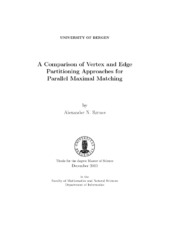A Comparison of Vertex and Edge Partitioning Approaches for Parallel Maximal Matching
Master thesis
Permanent lenke
https://hdl.handle.net/1956/7896Utgivelsesdato
2013-12-09Metadata
Vis full innførselSamlinger
Sammendrag
This thesis will compare two ways of distributing data for parallel graph algorithms: vertex and edge partitioning, using a distributed memory system. Previous studies on the parallelization of graphs has often been focused on a vertex partitioning, where each processor is assigned a set V' \(\subseteq\) V where G = (V,E), yielding a one-dimensional partitioning. It has been shown, however, that an edge partitioning (or 2D partitioning), where each processor is assigned a set E' \(\subseteq\) E, may yield a benefit in terms of a lower communication volume. The performance and scalability of vertex and edge partitionings are compared by implementing the Karp-Sipser matching set algorithm for both partitioning schemes. A matching set is a set E' \(\subseteq\) E of independent edges such that each vertex in V occurs at most once in E'. We find that while the vertex partitioned algorithm gives a significantly higher speedup, the increased performance of the edge partitioned algorithm on more dense graphs suggests that if the graph framework is improved further, it could lead to the implementation of an edge partitioned matching algorithm that offers better scalability and comparable matching quality to a vertex partitioned matching algorithm. An edge partitioning requires a rigorous framework for handling the communication resulting when edges owned by multiple processors are incident on the same vertex. Hopefully, the framework developed for representing an edge partitioned graph facilitates the implementation of other parallel graph algorithms using an edge partitioning approach.
